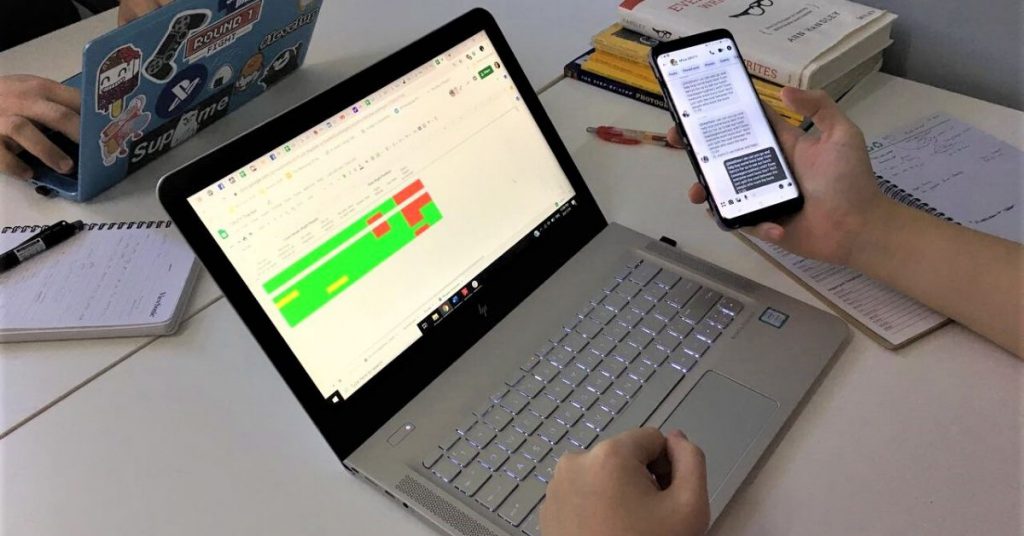For a long time, email was the go-to medium for workplace communication.
While still widely used, we are now feeling how inefficient they are compared to chat (or messenger) apps, especially when you need to discuss something quickly.
Whether it’s for the speed or smaller things like knowing if the person you are chatting with has seen your message (via features similar to WhatsApp’s blue ticks), chat apps have definitely changed the way we communicate in the workplace.
Here are 5 options I’ve picked to show what sort of features they offer.
1. Slack: Channel Based Communication
Google ’email killer’ and you would probably see Slack all over your result page.

From the minds that brought us Flickr, Slack is a popular communications app used by multiple big-name companies such as IBM, FOX and AirBnb.
You can create channels and fill them with relevant contacts, allowing you to easily organise teams, projects or just casual chat groups.
As the conversations inevitably get more cluttered, specific messages and files that were sent can be found again using Slack’s search function.
The in-built Slack Bot is not only a handy chatbot that can answer your FAQs, but you can also program it to give you and your team reminders or to automatically respond to select keywords.
Slack integrates over a thousand other apps and services from file storage services like Google Drive to organisational tools like Trello. It even supports more fun apps like GIF Keyboard.
You can try out Slack for free which will get you:
- A message history of 10,000 messages
- 10 integrated apps
- 5GB file storage
- 1-on-1 calls
However, they do have paid plans that come with more features too. Their Standard (US$6.67/month) and Plus (US$12.50/month) plans grant you unlimited message history, unlimited app integration, more file storage space, group calls, and 24/7 support.
2. Workplace: Facebook For Work
Now you have an excuse to use Facebook at work.

Workplace uses Facebook’s iconic UI to help turn your company into its own little community, with all the features that you are probably familiar with like posts, comments, chat boxes and groups.
It also integrates a number of tools such as Google Drive, Dropbox and Trello. Interestingly, it has an auto-translate feature for 46 languages too.
The free version already has all you need to start with, but US$4.00 per month (per user) will give you additional features such as:
- Bot APIs
- Organisation charts
- Monitoring tools
- Active Directory (G Suite and Azure) integrations.
US$8.00, on the other hand, will get you a dedicated support team, early access to new features, and an enhanced P2P video streaming feature called Enterprise Live.
AirAsia, Dominoes, Starbucks, and Walmart are just a few amongst the 30,000 companies that use this service.
If you have ever used Facebook (and who hasn’t these days), this should be the easiest to pick up and use.
3. Voxer: A Walkie Talkie App
You probably know some people who prefer to send voice messages on WhatsApp rather than text. This app is perfect for them.

Voxer markets themselves as a communication tool for high-performance industries like hospitality and logistics, with clients including Westin and Marriot.
Not everyone works in an office setting; in the industries mentioned above, staff are usually on-the-go and have no time to manually type out a text.
So, Voxer lets you record and send voice messages to one or a group of up to 500 people. One unique thing is that you can hear messages as the sender is speaking, or simply listen to them at a later convenience.
If you need to, you can still text and share things photos, videos, and even location. It also has voice-to-text transcriptions and Dropbox integration.
Priced at US$8.33 per month, there’s no free version for this one, but you can try it out with their 14-day free trial.
4. Cisco Webex Teams: Virtual Whiteboard
You know that old cliché about a picture being worth a thousand words?
Well, Cisco Webex Teams believes it. It was designed for more creative teams that would rather discuss matters visually.

Besides the usual text, voice and video call capabilities, this platform has a Whiteboard feature which allows you to sketch out your ideas in real-time.
The free version of the app allows you to hold video or voice meetings with up to 50 people for 40 minutes. It also grants you 1GB of cloud storage.
As for paid plans, there are 3 available ones: Starter (US$13.50 per month), Plus (US$17.95 per month), and Business (US$26.95 per month).
These plans afford you other features such as more storage space, app integrations, 24/7 customer support, analytics and even branding.
5. Microsoft Teams: Office 365 Integration
If your workplace is using Office 365 already, then it’s no big leap to also use Microsoft Teams.

It comes included in Office 365’s Business Premium Plan (US$12.50 per month), but there is a free standalone version available.
The free version gives you:
- Unlimited messages
- A max of 300 users
- 2GB per user and 10GB shared storage space
- Integration with over 140 apps and services.
The paid version includes more storage space and even more integrations with Office 365 services as well as with OneDrive, Sharepoint, Planner, and Yammer.
-//-
All these apps are available for iOS, Android and PC, and feature cross-platform compatibility.
Of course, this list is hardly an exhaustive one, and there are plenty of alternatives out there that may fit your particular needs.
In today’s fast-paced and tech-enabled world, having the ability to collaborate quickly and efficient can also give you a competitive edge.
Investing in an office chat platform can also lead to increased productivity and morale.
So do away with those email titles and lengthy cookie-cutter messages and move your workplace conversations into a chatbox.
Your team will thank you for it, probably with a thumbs-up emoji.
- You can read more about apps here.















